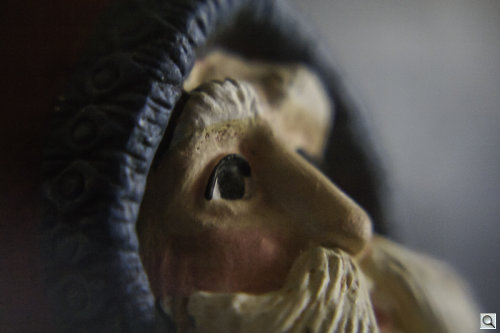Photo Corners headlinesarchivemikepasini.com
![]()
A S C R A P B O O K O F S O L U T I O N S F O R T H E P H O T O G R A P H E R
![]()
Enhancing the enjoyment of taking pictures with news that matters, features that entertain and images that delight. Published frequently.
Friday Slide Show: Knickknacks




25 August 2017
We'd been thinking about this shoot for a while, mostly as a last resort. Oh, if we really didn't have anything for our Friday Slide Show (we would think), we could always shoot the knickknacks.
With somewhere around 400 feet of book shelving in the studio (which, packed with books, also functions as R-30 insulation), we have a lot of knickknack storage. And, if we do say so ourselves, they are all quite charming.
Everyone thinks that about their knickknacks, of course. But when the old home is cleaned out, the knickknacks can't even be sold for $1 at the garage sale. Unless you have a personal attachment to these "trivial articles intended for ornament," they don't mean anything.
Ours all mean something. They each tell a story. And if we told each story, we'd have a big thick book of stories. And you could rely on it to put you to sleep each night for a month.
THE DAY COMES
Late yesterday as the fog was dimming into darkness, we wondered why we had never slapped the two Lensbaby macro converters onto the Lensbaby Tilt Transformer for Micro Four Thirds cameras. That, we realized, would give us a macro setup on the little camera.

Our Stack. Two telephoto converters on a double glass optic mounted to an adapter.
We have handheld one of the converters in front of the kit lens before. That works. But what if we played it straight?
That's one of the fun things about the Micro Four Thirds format. You can just about use any lens with the right adapter. And lenses are really what all the fun is about.
So we put the Tilt Transformer with its Composer Focus Front with the Double Glass Optic using an f5.6 aperture disc on the Olympus E-PL1 and screwed in both the +10 and +4 converters.
OBSTACLES
By then the light level in the bunker was pretty low. But we liked it. We refused to even think about bouncing a strobe off the white ceiling to help out. It would have ruined the mood.
We had a few things going for us, though.
First, the E-PL1 has in-body image stabilization. So we had help getting a sharp enough handheld image.
Second, we were shooting Raw so we could pick up the exposure in post processing.
On the other hand, the E-PL1 at ISO 1600 is pretty noisy. But there, too, we were going to be reducing these shots to 800-pixel images, binning the pixels, averaging them out, reducing the noise.
We very much liked the unfocused color and the play of light, both. They led to special effects we couldn't have planned but were delighted to discover.
As it turned out, our slowest shutter speed in Aperture Priority with Auto ISO was 1/25 second, no problem for the E-PL1. And you should have seen the close-up image shaking around in the EVF. We could hardly keep some of these in the frame.
Another issue was depth of field. With this optical setup, we weren't going to get any. But that turned into a creative constraint, something like squeezing your emotional rant into the lines of a sonnet.
We could angle the knickknack so our slice of focus included the features we wanted. Or we could simply select some feature to highlight. It was a creative choice we found a lot of fun to fool around with.
To see how shallow a depth of field we're talking about, look at that miniature sand dollar closely. It is an inch across and about an eighth of an inch deep. And we couldn't keep the whole thing in focus.
And with the f5.6 aperture disc, our corners were never going to be in focus, either.
THE LIGHT
There are a lot of different materials depicted in this set. They range from painted plaster to printed metal, from glass to chrome, from seashell to rubber, from clay to even a little marble. Among others.
Some of them were shot so you could clearly see what they were sitting on. Others float in front of a vague colored background. Setting the stage was part of the fun of this shoot.
We very much liked the unfocused color and the play of light, both. They led to special effects we couldn't have planned but were delighted to discover.
CONCLUSION
This was really a lot more fun than we expected. Especially at the end of the day.
And everything we know about taking competent photographs told us not to do it. From the low light level to the stacked optics to the handheld close-ups, it was all wrong. Mortal sins, really.
But as we lined up the shots in the viewfinder, we smiled. They looked great.
And the funny thing is, we did very little in post production. We edited the first image and synced all the rest, making just small tweaks to each. We'd have thought we would have to spend half the day making these presentable.
Sometimes you can break the rules without getting punished.
